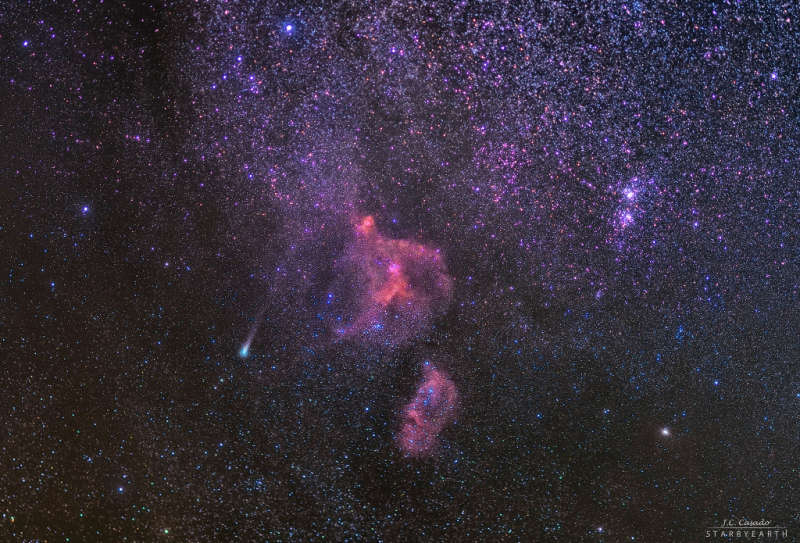Explanation: The greenish coma of comet 21P/Giacobini-Zinner stands out at the left of this telephoto skyscape spanning over 10 degrees toward the northern constellations Cassiopeia and Perseus. Captured on August 17, the periodic comet is the known parent body of the upcoming Draconid meteor shower. Predicted to be at its brightest next month, the comet is actually in the foreground of the rich starfield, only about 4 light-minutes from our fair planet. Giacobini-Zinner should remain too faint for your eye to see though, like the colorful Heart and Soul nebulae near the center of the sensitive digital camera's field of view. But the pair of open star clusters at the right, h and Chi Persei, could just be seen by the unaided eye from dark locations. The Heart and Soul nebulae with their own embedded clusters of young stars a million or so years old, are each over 200 light-years across and 6 to 7 thousand light-years away. They are part of a large, active star forming complex sprawling along the Perseus spiral arm of our Milky Way Galaxy. Also known as the Double Cluster, h and Chi Persei are located at about that same distance. Periodic Giacobini-Zinner was visited by a spacecraft from Earth when the repurposed International Cometary Explorer passed through its tail in September 1985.
1999 2000 2001 2002 2003 2004 2005 2006 2007 2008 2009 2010 2011 2012 2013 2014 2015 2016 2017 2018 2019 2020 2021 2022 2023 2024 2025 |
Январь Февраль Март Апрель Май Июнь Июль Август Сентябрь Октябрь Ноябрь Декабрь |
NASA Web Site Statements, Warnings, and Disclaimers
NASA Official: Jay Norris. Specific rights apply.
A service of: LHEA at NASA / GSFC
& Michigan Tech. U.
|
Публикации с ключевыми словами:
comet - nebula - кометы - туманность
Публикации со словами: comet - nebula - кометы - туманность | |
См. также:
Все публикации на ту же тему >> | |
